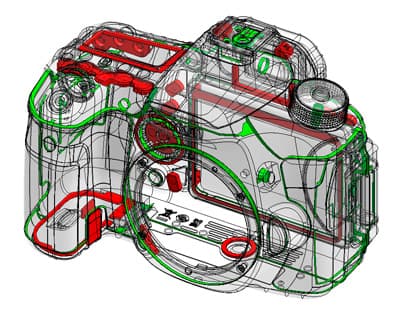**Read our full news article about the Canon EOS 70D here**
Released in 2010, the Canon EOS 60D became one of the company’s most popular DSLRs. Now, almost three years later it is to be replaced with the Canon EOS 70D.
While the new camera inherits its predecessor’s polycarbonate body and has a similar vari-angle screen, it also has significant improvements to its autofocus system. The Canon 70D has 19 AF points, all of which are cross-type points, like the more advanced EOS 7D. The new camera also has built-in Wi-Fi connectivity, like the Canon EOS 6D that was released at Photokina last year.
However, of all of the new features that Canon has added to the Canon 70D it is the design of the sensor that is by far the most interesting.
Canon EOS 70D – New Sensor Technology
The key new feature of the Canon EOS 70D is its new intriguing, and unique, sensor. The sensor follows on from the recent cameras we have seen that use some of the photodiodes on the sensor to allow a form of on-sensor phase-detection autofocus

Designed and manufactured by Canon, the 20.2 million Dual Pixel CMOS APS-C size sensor has an impressive sensitivity range of ISO 100-12,800, with an extended 25,600 option. However, the most interesting aspect of the sensor is that it has two photodiodes for each pixel.
This means that when the light from the camera lens isn’t focused correctly the light reaching each of the photodiodes will vary slightly. The Canon EOS 70D’s DIGIC 5+ processor can quickly analyse the difference between the light reaching each pair of photodiodes, and focus the camera lens so that the light reaching each of the photodiodes is identical. In effect each pair of photodiodes works in a similar way to a regular phase-detection AF sensor. Canon are calling the technology Dual Pixel CMOS AF.


Of course, the advantage of using phase-detection AF on the camera’s sensor is that it can be used when shooting using in live view, or more importantly, when shooting video footage.
I tried the new AF system on a pre-production model of the Canon EOS 70D and found that the Dual Pixel CMOS AF and it is certainly faster than the on-sensor phase detection that we have previously seen on Canon cameras. While not as fast as conventional phase detection which, of course, the Canon EOS 70D also has, it is certainly a big improvement on contrast-detection AF.
The entire 20.2-million-pixel sensor of the EOS 70D uses the dual photodiode arrangement, but the Dual Pixel CMOS AF AF is only active over 80% of the sensor area. A representative from Canon UK explained to us that this is because the pixels at the edges of the sensor were less accurate when used for focusing with this method.
See a video of the new AF system in action on the Canon Japan website
When the Dual Pixel CMOS AF is used with Canon STM lenses, focusing is almost silent. Canon told us that the new AF system is fully compatible with 103 Canon EF lenses. However, there are around 25 lenses that cannot take advantage of the new AF system, but obviously these work fully with the cameras regular phase-detection AF.
The light from both photodiodes is used when creating a single pixel in the captured image. This is why the sensor has a 20.2-million-pixel resolution rather than a 40.4-million pixel-resolution. We were assured by Canon that the photodiode arrangement doesn’t reduce image quality in any way. We are obviously looking forward to putting this claim to the test, and seeing just how good the Dual Pixel CMOS AF is when we test a full production version of the camera in the coming weeks.
Canon EOS 70D – Viewfinder, Electronic Level and AF modes
The sensor of the Canon EOS 70D isn’t the only new feature. The viewfinder has a 98% field of view and it uses the same intelligent display technology that is also found in the EOS 7D. New graphics have been added to the optical viewfinder overlay to improve the electronic level feature. The new level graphic sits below the AF arrangement at the bottom of the viewfinder. Previously the AF points themselves were used to indicate whether the camera was level or not. Now the dedicated electronic level graphic makes it even easier to see if the camera is perfectly straight.
Also improved is the way that the AF mode can be selected. There is now a dedicated AF mode button between the control dial and the shutter button on the 70D’s top-plate. When this button is pressed the AF mode in use is displayed in the viewfinder. Pressing the button again will toggle to the other available AF mode, and turning the control dial allows the AF selection points to be changed.
This makes it possible to change the AF mode and the points in use without moving the eye away from the viewfinder. This system was fully working in the pre-production camera we tried and the system is an excellent way of working. It should be of particular interest to those who shoot moving subjects, such as wildlife photographers.


The Canon EOS 70D has a weather sealed body
The shooting rate of the Canon EOS 70D will also be of interest to those keen on wildlife photography. The camera can shoot full resolution images at 7fps for 16 raw files or 65 JPEG files, when using a UHS-I SD card.
Like the recent EOS 700D the Canon 70D has a 3in Vari-angle touchscreen, as well as the same multiple exposure, HDR capture, and creative filter modes.

Canon EOS 70D – First Impression
With the Canon EOS 60D having been in the market now for over two and a half years, the EOS 70D is a very important camera for the company. While the resolution of the cameras sensor hasn’t increased dramatically, this isn’t necessarily a bad thing. In the past couple of years dynamic range and noise reduction has improved, and by keeping the resolution at a reasonable level there is a good chance that the EOS 70D will produce excellent images.
However, it remains to be seen whether the new Dual Pixel CMOS AF technology built in to the cameras sensor will have any effect on the quality of images. It will also be interesting to see how this method of autofocus really compares to standard phase and contrast detection AF.
The Canon EOS 70D will be available at the end of August priced £1,079.99 body only, £1,199.99 with an 18-55 mm STM kit lens, and £1,399.99 with an 18-135 mm STM lens.








